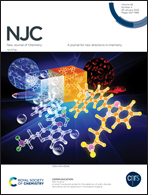Regulation of Ni/Al2O3 catalysts by metal deposition procedures for selective hydrogenation of adiponitrile†
Abstract
An understanding of the essential roles in adiponitrile hydrogenation is a significant factor in designing promising nickel catalysts. A series of Ni/Al2O3 catalysts have been synthesized by the deposition–precipitation method and used for the selective hydrogenation of adiponitrile. The formation of the Ni compositions and the chemical structures of the catalysts were modulated by the assisting precipitators. Characterization, including XRD, N2 adsorption–desorption, TEM, XPS, H2-TPD and NH3-TPD, were carried out. Smaller particles could be obtained via fast deposition of Ni2+ using NaOH in Ni/Al2O3–OH, or uniform crystal seeds using urea in Ni/Al2O3–U. The use of a strong alkali, and the formation of nickel hydroxide, facilitated the generation of Ni0 with a better H2 activation ability. Meanwhile, a huge number of nickel species in various oxidative states and strong acidity were simultaneously generated in Ni/Al2O3–U, leading easily to the cycloaddition by-products. A kinetics study revealed that adiponitrile hydrogenation is a second-order reaction with respect to adiponitrile. The number of Ni0 active sites and acid sites could be balanced via different precipitation and crystallization methods. The yield of 1,6-hexanediamine reached 75.0% at 90 °C with 20 wt% Ni/Al2O3–OH.



 Please wait while we load your content...
Please wait while we load your content...